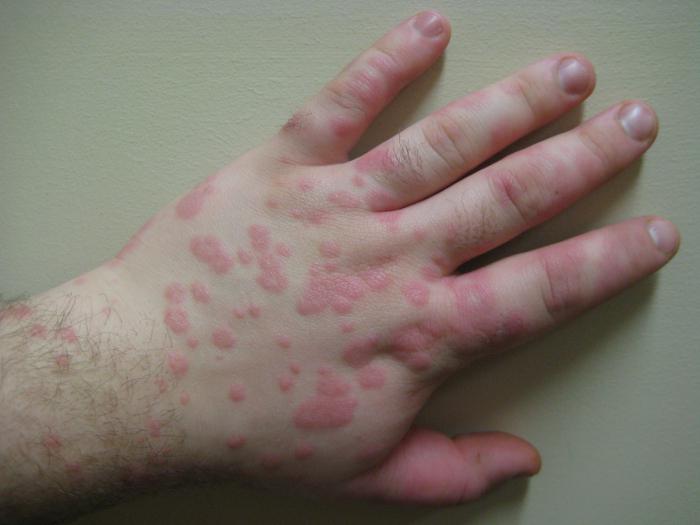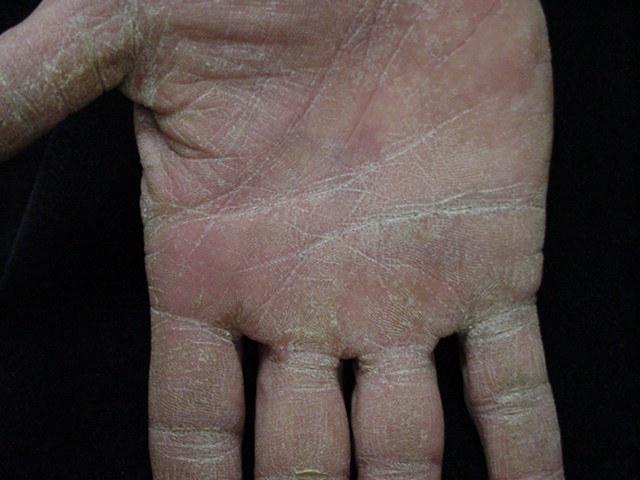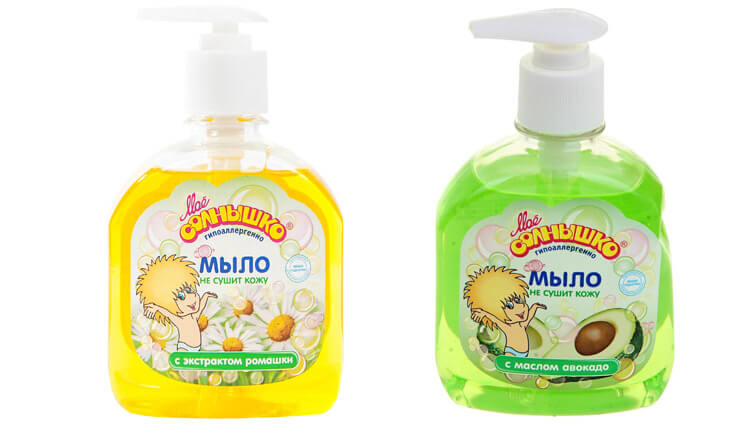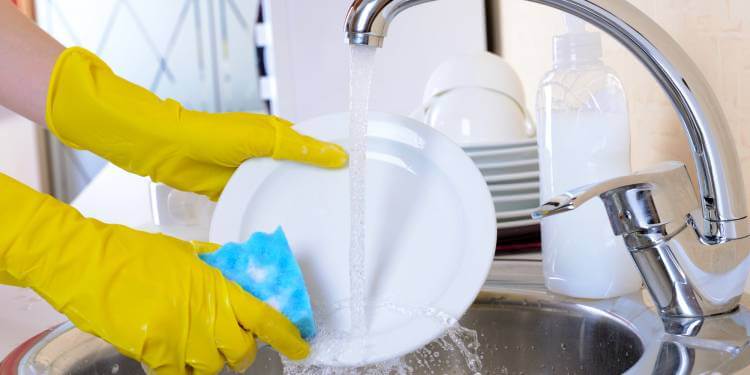What will help with skin irritation on the hand. Hand allergy to detergents
Probably, there is not a single person who didn’t get irritated on his hands even once in his life. Therefore, it is clear to everyone how unpleasant it is, albeit in most cases painless. And how uncomfortable women feel that at such moments they feel their aesthetic imperfection! And in order to try to avoid another similar experience, let's find out why there is irritation in the hands and how you can avoid the “meeting” with it.
What causes irritation
Most often, the reasons for its appearance are quite harmless. It manifests itself primarily in the hands, as they are most accessible to external influence. Among the factors causing irritation on the hands, the most frequent are:
- Sharp temperature change.
- Dryness or, conversely, excessive humidity.
- Poor-quality household products: detergents and cleaning products, cosmetics, washing powder, from which not enough thoroughly washed out linen, etc.
- Cold air.
- Synthetics used to make a bed or clothes.
- All kinds of allergies: dust, wool, food.
- Irritation of the skin on the hands may follow the mechanical impact (tight clothing, which is constantly in contact with the body, regular friction when working at the computer, shaving if you shave your hands).
- Professional reasons - when working with chemical or volatile (like cement) substances.
However, it is worth remembering that irritation in the hands can also be a symptom of some diseases. In adults, it most often signals digestive problems. 
Allergy to low temperatures
The most unpleasant is irritation in the hands of the cold, because a person during his life cannot be completely isolated from the cold - unless he moves to a tropical country and stops using the refrigerator. Why there is a cold allergy, it is not established, however the list of the factors provoking its manifestations is found out. Among them:
- Sharp decrease in temperature. For example, when leaving a warm apartment in the cold, especially when the wind.
- Contact with cold water, even short-term.
- Eating cold food or drinking cold drinks.
- Allergy - any. It reduces the resilience and "frees the way" cold.
- Some infections like tuberculosis and their treatment with antibiotics. Often, the reaction to frost occurs after helminth diseases.
- Long stress.
- Heredity.
In the latter case, the irritation on the hands rather caused by a humid wind, rather than low temperature. 
Prevention of cold allergies
This reaction of the body is especially unpleasant because it can result in swelling, blisters, and in rare cases - problems with breathing. Therefore, a person who has had irritation in his hands from the cold, must take certain measures to prevent its recurrence. I.e:
- Warm and layered dress. It is better to wear two thin sweaters than one thick: the layer between them will warm additionally.
- Underwear to buy only natural cotton to avoid allergies.
- Drink hot milk or tea before going to the frost, and smear your face with a fat cream.
- Wash only with warm water.
- Do not drink cold drinks and warm food that is removed from the refrigerator.
- Do not swim in the cold sea (river, lake, etc.).
And if the irritation on the hands still appeared, immediately take action: make soda lotions or lubricate with oil vitamin E.
Dermatitis
No less frequent factors causing irritation on the hands are atopic and contact dermatitis. Almost all children go through the first one at the age of two months - parents fight with diathesis regularly. Someone he passes, someone can stay until the end of life, it depends on heredity.
Contact dermatitis is an allergic irritation on the hands and other parts of the body associated with touching the skin with an allergen. If it is found out what the body reacts to, you just need to avoid contact with the substance (for example, clean the oven with gloves). Relief of symptoms is achieved by the use of antihistamines.
Rash in a child as a sign of the disease

It is necessary to be much more picky if there is irritation in the hands of a child. First of all, it can be a symptom of any of the specifically childhood diseases: rubella, measles, chickenpox or scarlet fever. The sooner in this case the baby is examined by a pediatrician, the better for his health.
In addition to serious diseases, irritation in the hands of a child may be caused by hemorrhagia. There is nothing dangerous for the baby in this, except for discomfort (and even that is easy) and the danger of scratching to the blood, which happens not so often. However, in order to avoid diaper rash, it is better to pay attention to the rash.
Much worse if the irritation in the hands of a child appeared due to scabies. Not seen in time, it can spread throughout the body, and to other family members. So if the baby has a rash, it is better to immediately contact the clinic.
Irritation on the hands creates physical and psychological discomfort, and in some cases is a symptom of the disease. When choosing methods of treating irritation on the skin of the hands, the cause of the dermatological manifestation is of decisive importance.
How to treat irritation on the hands?
Consider several ways to treat irritation depending on what caused such a nuisance.
Aggressive household chemicals
Most women do their homework on their own, so after using household chemicals, problems with the hands are possible. Along with drying the skin, irritation and rashes on the hands may occur. Therefore, the advice to work at home in rubber gloves is relevant, despite the fact that many manufacturers point to the hypoallergenicity of their products. For the purpose of treating irritation on the hands of detergents, moisturizing masks and wraps with the addition of natural oils (tea tree, calendula, chamomile, lavender) are used.
Food allergies
If irritation appeared on the hands, and besides, the skin itches, then an allergic reaction to foodstuffs is most likely to occur. In this case, you need to revise your menu, excluding food that causes allergies. It is also desirable to introduce into the daily diet green vegetables, milk and dairy products, poultry or veal. It is desirable to use seafood more often and eat beet dishes. To relieve severe itching and irritation with increased reactivity, hormonal ointments and antihistamines are used.
Allergy to cold
Cold allergy , arising as a response to the effects of natural factors (cold, wind), also manifests itself in the form of swelling of hands, cracks and irritation. In this situation it is necessary to exclude the contact of the skin of the hands with cold air. To do this, it is recommended to lubricate your hands before going out with special creams and wear warm gloves.
Atopic dermatitis
This is a disease that is especially difficult to cure. As a rule, the disease is inherited, provoking it  occurrence factor is experiencing a stressful situation. Adding an infection can cause a rash, red spots and sores. Antibacterial ointments, for example, Triderm, Elok, as well as hormone-based products, save from irritation on the hands.
occurrence factor is experiencing a stressful situation. Adding an infection can cause a rash, red spots and sores. Antibacterial ointments, for example, Triderm, Elok, as well as hormone-based products, save from irritation on the hands.
Fungus
Sometimes spots and irritation on the hands can be a manifestation of fungal diseases, indicate the presence of worms in the body, signal a lack of vitamins. In this regard, with long-term or regularly occurring rashes, it is necessary to consult a dermatologist for advice.
Allergy is a manifestation of the body's defensive reaction to external stimuli. If the skin of your hands suddenly became dry, itchy and red rash appeared, analyze, maybe a new detergent or powder appeared in your house?
Each housewife has a whole arsenal of detergents: for dishes, bathtub, glasses, etc. They are indispensable assistants in the fight for cleanliness, but more often they cause allergic reactions. The composition of such funds include aggressive substances, which become the cause of allergies.
What is the reason
There are several reasons for the appearance of an allergic reaction to detergents. They can be divided into two main groups:
- the action of active stimuli;
- individual features of the body.
Active stimuli include components included in the product:
- phosphates;
- bleach;
- flavors and fragrances;
- emollient additives.
Each of them can cause allergies, including the supposedly safe formulations of children's powders and dish detergents.
The individual characteristics of the body include:
- intolerance to the chemical elements that make up the product;
- weakened immunity, which is not able to prevent the negative effects of household chemicals;
- prolonged skin contact with detergent.
When colliding with an unfamiliar substance, the body begins to produce protective antibodies and includes a response in the form of an allergic reaction to an irritant. This process is called sensitization.
How to recognize the symptoms
The manifestation of allergies to detergents is almost no different from allergies to other stimuli. It can occur in areas of skin that are in direct contact with an irritant, or throughout the body. Its most common symptoms include:
- redness;
- dryness, flaking and cracking of the skin;
- feeling itchy;
- irritation and rash;
- red spots;
- chemical burn (in rare cases).
Below are photos of symptoms in the hands of people who have been affected by the effects of detergents.


The reaction of the organism can be different: one may be allergic to dryness and itching, and from the other one can even get a chemical burn. There is a cumulative effect. If at first, in contact with the medium, the skin became covered with red spots, then, if you do not stop using it, for example, Quincke’s edema may develop.
How to treat
The treatment of any type of allergy consists primarily in minimizing unpleasant symptoms and alleviating a person’s condition. If you find that during cleaning you have redness and itching of the skin of your hands, you should immediately stop contact with the detergent, wash your hands and treat them with an antihistamine.
To eliminate the external manifestations of allergy, a number of drugs and cosmetics are also used:
- antihistamines - as in the form of tablets (Loratadin, Claritin, Suprastin, Tavegil), and in the form of ointments for external use (Fenistil, Psilo-balsam). They are necessary to eliminate the rash, itching and redness;
- topical corticosteroids - hormonal drugs with strong anti-inflammatory and antipruritic effects (Triderm, FluoroCort, Fluciner, etc.). They have side effects, therefore they are prescribed in difficult cases by a short course, after which it is recommended to switch to weaker drugs;
- calcium gluconate - has the ability to inhibit immune cells responsible for the development of an allergic reaction;
- special cream emollients - on the basis of paraffin, wax, silicone, vaseline, mineral, vegetable and animal oils (Emolium, Lokobeyz, A-Derma Ekzomega). Shallow penetration into the skin, forming on it a thin film that prevents the evaporation of moisture. As a result, the water-lipid layer of the skin is restored, dryness and itching disappear, microcracks heal.

Sometimes severe itching leads to scratching of the skin, wounds and suppurations are formed on it. In such cases, an antibiotic ointment is prescribed. When the wounds heal, you can continue to use conventional antihistamine ointment.
Of course, in the future it is better not to work with the agent that caused the allergy, replacing it with a less aggressive one. And it is better to always wear gloves to prevent any contact of detergents with the skin of hands.
Remember that timely treatment of allergic manifestations will help to avoid a serious disease - dermatitis of the skin, often of a chronic nature.
How to prevent and how to replace
Allergy to detergents - not a deadly disease, though rather unpleasant. The best means of prevention would be the rejection of detergent-cleaning-powder means. But this is impossible. Therefore, try to follow some rules that will help minimize the risk of an allergic reaction.
- when buying powder, dishwashing gel or floor-washing concentrate, carefully study their composition: it is better if there is no ammonia, chlorine, fragrances, phenol, acetone;
- a proven method for washing dishes is baby liquid soap;

- use products marked “for sensitive skin” or “hypoallergenic”. Unfortunately, this is not an absolute guarantee that there will be no allergies, but, in case of its occurrence, the symptoms will be mild;
- try not to use detergent all the time. Of course, one cannot get away from daily washing up, but for other types of cleaning it is not necessary to use special products every day;
- and, as already mentioned, the optimal solution is gloves. Use them to protect yourself as much as possible from an allergic reaction and keep your hands skin young and healthy.

Do not forget that in the struggle for purity, natural means are in no way inferior to modern household chemicals.
Our grandmothers' faithful helpers - vinegar, citric acid, baking soda and mustard:
- vinegar - an excellent tool for washing windows, for cleaning plumbing or getting rid of limescale;
- lemon acid will easily remove scale in a washing machine or electric kettle;
- baking soda can be used to clean any surfaces, it will disinfect the surface, eliminate the unpleasant odor and at the same time - no stains;
- mustard - This is a 2-in-1: dishwashing detergent and washing powder for hand and machine washing.
Allergy to detergents is also called the disease of purity. Fortunately, today many manufacturers of household chemicals focus on "safe" cleanliness and produce products without harmful chemical additives. On their funds you can find the mark "Bio", "Eko" or "Organic". But an allergen can be any substance, including natural. Therefore - be careful and take care of your hands!


